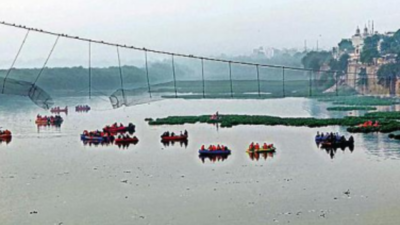Top Searches
- News
- City News
- ahmedabad News
- Morbi collapse: Gujarat govt increases ex gratia payment
Morbi collapse: Gujarat govt increases ex gratia payment

The government informed the court on Monday that, on December 10, it took a decision to increase the ex gratia payment to the kin of the deceased by Rs 4 lakh, making it a total of Rs 10 lakh
AHMEDABAD: Following Gujarat high court's suggestion, the state government has increased the compensation amount for victims of the Morbi suspension bridge tragedy. On October 30, a colonial-era bridge on the Machchu river had collapsed, killing 135 persons.
The government informed the court on Monday that, on December 10, it took a decision to increase the ex gratia payment to the kin of the deceased by Rs 4 lakh, making it a total of Rs 10 lakh. Of this, Rs 8 lakh will be given from the Chief Minister's Relief Fund and Rs 2 lakh from the Prime Minister's Relief Fund.
To the 56 persons who sustained injuries, the government will pay Rs 2 lakh more to each with more than 40% disability, and Rs 1 lakh each to those with less than 40% disability.
The advocate general told the court that the amount would be disbursed within a day or two. Besides, the high court commented that the state government did not take action against the Morbi municipality under Section 263 of the Municipalities Act and its chief officer as was assured to the court on November 24.
During the hearing, the advocate general stated that dissolution of the municipality is being contemplated, but the affidavit stated that the decision would be taken after the perusal of the Special Investigation Team's (SIT) report.
Meanwhile, the state government submitted SIT's preliminary report in a sealed cover to the high court. The bench of Chief Justice Aravind Kumar and Justice Ashutosh Shastri took note of the recommendations made by the SIT which emphasized on the need to maintain a register for public structures, and periodic audit of these structures.
The SIT also suggested that upkeep of such facilities should be designated to competent personnel. The storage of rescue equipment in case of exigencies was also recommended.
The SIT report revealed that the main cable was formed by seven cords, each comprising seven wires. Out of the 49 wires, 22 were already corroded and had broken much before the bridge collapsed.
No load test was conducted on the structure before the bridge was thrown open to the public on October 26. The movement of people was also not regulated on the bridge. Moreover, the SIT stated that Ajanta Manufacturing Co Ltd outsourced the repair work to a non-competent agency.
The state government did not respond to the HC's directions on formulating a policy regarding regulatory mechanism and rehabilitation during such a tragedy. The SIT also recommended the same measures. This led the HC to direct the government to place before it a proposed policy and specify the number of public structures, and structures used by people regularly.
The high court asked for details about such structures after the government told the court that there is only one suspension bridge like the one at Morbi and it is at Rajendra Baug in Rajkot. However, it is not open to public because it is in a bad and critical condition.
After the HC asked how the district collector could sign an MoU with Ajanta for the bridge's management when the bridge was the municipality's property, the Morbi municipality told the HC that on August 4, 2007, its executive committee had empowered the collector to do so.
As Dilip Chavda, the petitioner and a relative of the victims, could not furnish Ajanta's address in his petition, the HC asked him to file a fresh application with details and posted the matter for hearing on December 21 when it might issue a notice to Ajanta's owner or management.
The government informed the court on Monday that, on December 10, it took a decision to increase the ex gratia payment to the kin of the deceased by Rs 4 lakh, making it a total of Rs 10 lakh. Of this, Rs 8 lakh will be given from the Chief Minister's Relief Fund and Rs 2 lakh from the Prime Minister's Relief Fund.
To the 56 persons who sustained injuries, the government will pay Rs 2 lakh more to each with more than 40% disability, and Rs 1 lakh each to those with less than 40% disability.
The advocate general told the court that the amount would be disbursed within a day or two. Besides, the high court commented that the state government did not take action against the Morbi municipality under Section 263 of the Municipalities Act and its chief officer as was assured to the court on November 24.
During the hearing, the advocate general stated that dissolution of the municipality is being contemplated, but the affidavit stated that the decision would be taken after the perusal of the Special Investigation Team's (SIT) report.
Meanwhile, the state government submitted SIT's preliminary report in a sealed cover to the high court. The bench of Chief Justice Aravind Kumar and Justice Ashutosh Shastri took note of the recommendations made by the SIT which emphasized on the need to maintain a register for public structures, and periodic audit of these structures.
The SIT also suggested that upkeep of such facilities should be designated to competent personnel. The storage of rescue equipment in case of exigencies was also recommended.
The SIT report revealed that the main cable was formed by seven cords, each comprising seven wires. Out of the 49 wires, 22 were already corroded and had broken much before the bridge collapsed.
No load test was conducted on the structure before the bridge was thrown open to the public on October 26. The movement of people was also not regulated on the bridge. Moreover, the SIT stated that Ajanta Manufacturing Co Ltd outsourced the repair work to a non-competent agency.
The state government did not respond to the HC's directions on formulating a policy regarding regulatory mechanism and rehabilitation during such a tragedy. The SIT also recommended the same measures. This led the HC to direct the government to place before it a proposed policy and specify the number of public structures, and structures used by people regularly.
The high court asked for details about such structures after the government told the court that there is only one suspension bridge like the one at Morbi and it is at Rajendra Baug in Rajkot. However, it is not open to public because it is in a bad and critical condition.
After the HC asked how the district collector could sign an MoU with Ajanta for the bridge's management when the bridge was the municipality's property, the Morbi municipality told the HC that on August 4, 2007, its executive committee had empowered the collector to do so.
As Dilip Chavda, the petitioner and a relative of the victims, could not furnish Ajanta's address in his petition, the HC asked him to file a fresh application with details and posted the matter for hearing on December 21 when it might issue a notice to Ajanta's owner or management.
FOLLOW US ON SOCIAL MEDIA
FacebookTwitterInstagramKOO APPYOUTUBE
Start a Conversation
end of article









